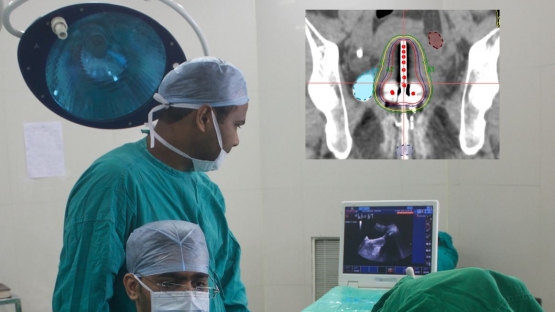Cervical cancer patients often require a specific, technically challenging treatment that is not always readily available in developing countries. In Asia, which accounts for close to half of the world’s cervical cancer deaths, the IAEA has completed a four-year project to increase survival rates. Over 1000 specialists were trained on 3D image-guided brachytherapy, an advanced form of radiotherapy.
“Many Asian countries have insufficient capacity to provide radiotherapy, which is a vital element of cancer control,” said IAEA Director General Yukiya Amano in a video message to an international symposium of the Japanese Society for Radiation Oncology (JASTRO), marking the end of the project. “This means that patients often die of cancers which could be effectively treated if they lived in a country with well-developed cancer facilities. Our mission is to transfer technologies to help save lives.”
What is brachytherapy?
While external beam radiotherapy directs ionizing radiation towards a tumour from outside the body, in brachytherapy radioactive sources are placed directly into a tumour or body cavity. This helps concentrate the radiation dose in the tumour, increasing the probability of killing it, while sparing adjacent organs and tissues from being harmed.
“Although there are many difficulties in implementing 3D image-guided brachytherapy, including shortages of equipment and manpower, the number of institutes implementing it has been dramatically increasing, thanks to the involvement of the IAEA and its partners,” said Shingo Kato, Professor of Radiation Oncology at the Saitama Medical University in Japan. Professor Kato has been lead country coordinator for this project since 2012.
3D image-guided brachytherapy is very effective in managing cervical cancer, which, according to GLOBOCAN, caused an estimated 266 000 deaths in 2012 worldwide.
Fighting cervical cancer in the Philippines
The technology has greater impact than traditional methods and leads to longer survival rates for patients who have gynaecological cancers, explained Miriam Calaguas, Chair of the Department of Radiation Oncology at St. Luke's Medical Center near Manila in the Philippines.
Of all cervical cancer deaths, more than 85% occur in less developed countries. In Asia, cervical cancer is the second most common cancer among women, killing more than 144 000 patients annually and accounting for almost half of all deaths related to cervical cancer worldwide. The number of deaths from cervical cancer in Asia is expected to nearly double by 2035, according to GLOBOCAN.
The IAEA has supported hospitals such as the Jose R. Reyes Memorial Medical Center that requested training on the introduction of the new technique. The IAEA trained 114 professionals directly, and over 1050 specialists were trained in follow-up country projects, including more than 150 specialists were trained in the Philippines alone.
IAEA experts have developed guidelines for the transition to 3D high dose rate brachytherapy, said Elena Fidarova, Radiation Oncologist at the IAEA, who chaired the international symposium at the JASTRO meeting. An IAEA publication entitled The Transition from 2D Brachytherapy to 3D High Dose Rate Brachytherapy publication provides important guidance to all those upgrading their facilities to introduce 3D image-guided brachytherapy, she said. The IAEA has also developed a clinical guide for the treatment of cervical cancer – Management of Cervical Cancer: Strategies for Limited-resource Centres - A Guide for Radiation Oncologists – that is designed for low and middle-income countries, where practitioners treat a large number of patients daily, often with very limited resources.
Many Asian countries have insufficient capacity to provide radiotherapy, which is a vital element of cancer control.





